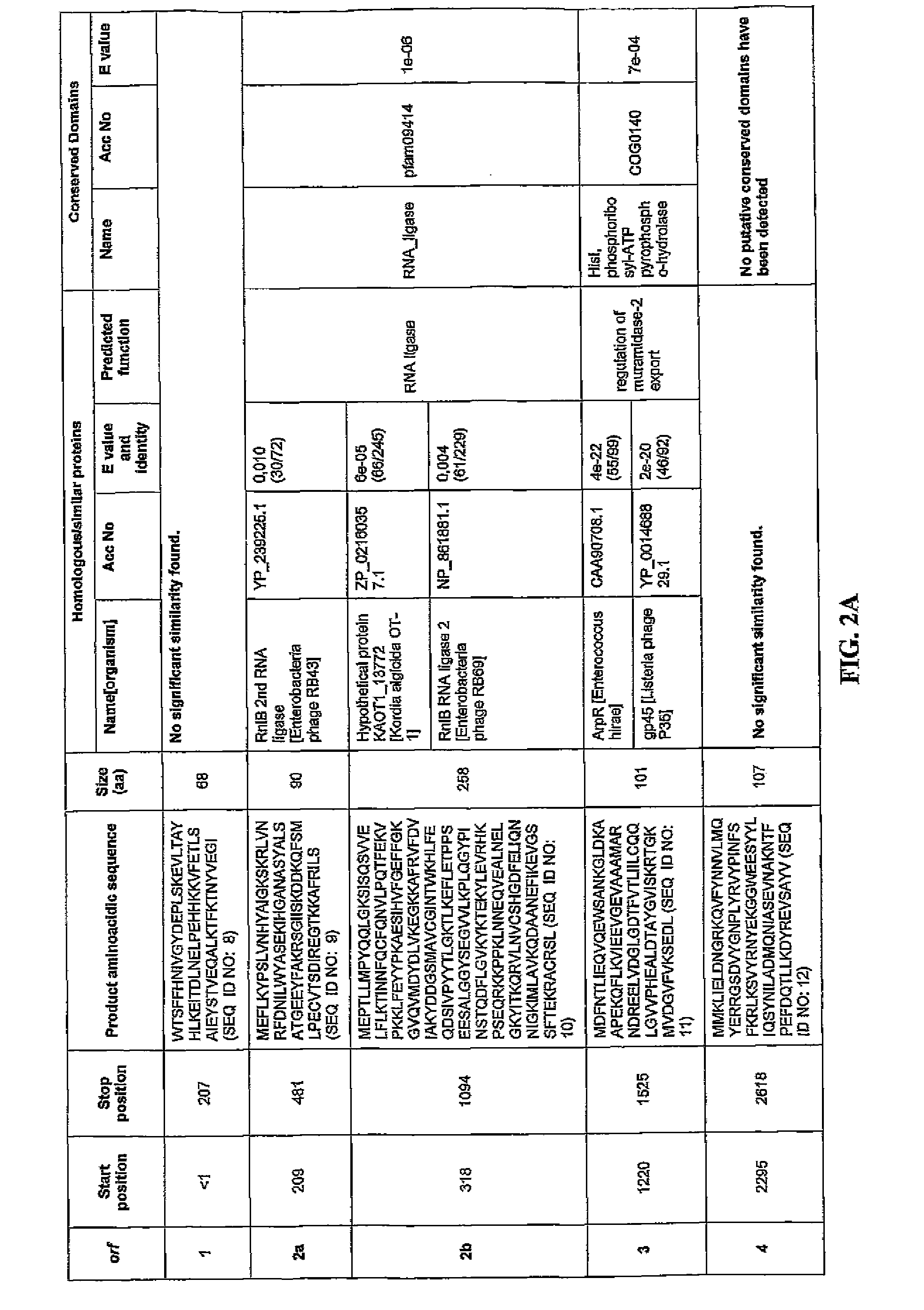Antibacterial phage, phage peptides and methods of use thereof
- Summary
- Abstract
- Description
- Claims
- Application Information
AI Technical Summary
Benefits of technology
Problems solved by technology
Method used
Image
Examples
example 1
Bacteriophage F168 / 08
[0143]Comparison of the putative ORFs of the bacteriophage F168 / 08 genome with the sequences in the NCBI nucleotide database revealed that only small portions of the genome (≦1%) exhibited homology with known sequences. The F168 / 08 ORFs, their encoded amino acid sequences and known homologous proteins are provided in FIG. 2. Prediction of orfs was performed by integrating the results obtained with GeneMark.hmm and MetaGeneAnnotator programs (Besemer, J. and Borodovsky, M. 1999. Nucleic Acids Res., 27: 3911-3920; Noguchi, H. et al., 2008. DNA Res., 15: 387-396). Protein homology searches were carried out with BLASTP program (Alschul, S.F. et al., 1997. Nucleic Acids Res., 25: 3389-33402) using the NCBI non-redundant protein sequences database. Protein conserved domains were predicted using NCBI specialized BLAST (Marchler-Bauer, A. et al., 2007. Nucleic Acids Res. 35: 237-240). orfs whose products presented homology with the same protein(s) are indicated with the...
example 2
Bacteriophage F170 / 08
[0145]Comparison of the putative ORFs of the bacteriophage F170 / 08 genome with the sequences in the NCBI nucleotide database revealed that about 94% of its genome was highly similar to that of Enterococcus phage ΦEF24C, with individual ORF identities ranging from 80 to 100%. The F170 / 08 ORFs, their encoded amino acid sequences and known homologous proteins are provided in FIG. 5. Prediction of orfs was performed by integrating the results obtained with GeneMark.hmm and MetaGeneAnnotator programs (Besemer, J. and Borodovsky, M. 1999. Nucleic Acids Res., 27: 3911-3920; Noguchi, H. et al., 2008. DNA Res., 15: 387-396). Protein homology searches were carried out with BLASTP program (Alschul, S. F. et al., 1997. Nucleic Acids Res., 25: 3389-33402) using the NCBI non-redundant protein sequences database. Protein conserved domains were predicted using NCBI specialized BLAST (Marchler-Bauer, A. et al., 2007. Nucleic Acids Res. 35: 237-240). ° ifs whose products presente...
example 3
Bacteriophage F770 / 05
[0147]Comparison of the putative ORFs of the bacteriophage F770 / 05 genome with the sequences in the NCBI nucleotide database revealed that only small portions of the genome (≦1%) exhibited homology with known sequences. The F170 / 05 ORFs, their encoded amino acid sequences and known homologous proteins are provided in FIG. 8. Prediction of ° ifs was performed by integrating the results obtained with GeneMark.hmm and MetaGeneAnnotator programs (Besemer, J. and Borodovsky, M. 1999. Nucleic Acids Res., 27: 3911-3920; Noguchi, H. et al., 2008. DNA Res., 15: 387-396). Protein homology searches were carried out with BLASTP program (Alschul, S. F. et al., 1997. Nucleic Acids Res., 25: 3389-33402) using the NCBI non-redundant protein sequences database. Protein conserved domains were predicted using NCBI specialized BLAST (Marchler-Bauer, A. et al., 2007. Nucleic Acids Res. 35: 237-240).
[0148]FIG. 9 provides the results of spot tests that assessed the activity of the bac...
PUM
| Property | Measurement | Unit |
|---|---|---|
| Fraction | aaaaa | aaaaa |
| Fraction | aaaaa | aaaaa |
| Fraction | aaaaa | aaaaa |
Abstract
Description
Claims
Application Information
 Login to View More
Login to View More - R&D Engineer
- R&D Manager
- IP Professional
- Industry Leading Data Capabilities
- Powerful AI technology
- Patent DNA Extraction
Browse by: Latest US Patents, China's latest patents, Technical Efficacy Thesaurus, Application Domain, Technology Topic, Popular Technical Reports.
© 2024 PatSnap. All rights reserved.Legal|Privacy policy|Modern Slavery Act Transparency Statement|Sitemap|About US| Contact US: help@patsnap.com










